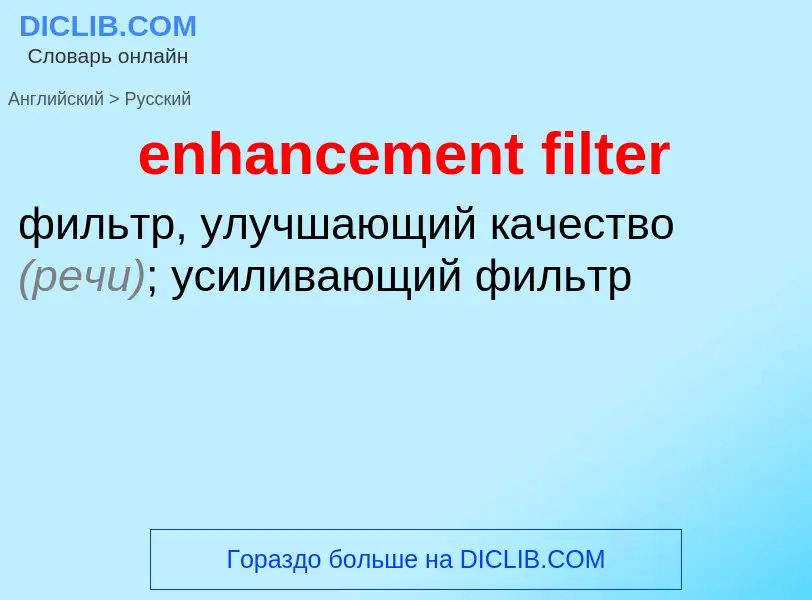Vertaling en analyse van woorden door kunstmatige intelligentie ChatGPT
Op deze pagina kunt u een gedetailleerde analyse krijgen van een woord of zin, geproduceerd met behulp van de beste kunstmatige intelligentietechnologie tot nu toe:
- hoe het woord wordt gebruikt
- gebruiksfrequentie
- het wordt vaker gebruikt in mondelinge of schriftelijke toespraken
- opties voor woordvertaling
- Gebruiksvoorbeelden (meerdere zinnen met vertaling)
- etymologie
enhancement filter - vertaling naar russisch
общая лексика
режим обеднения
общая лексика
съемочный светофильтр
Definitie
Wikipedia

In photography and cinematography, a filter is a camera accessory consisting of an optical filter that can be inserted into the optical path. The filter can be of a square or oblong shape and mounted in a holder accessory, or, more commonly, a glass or plastic disk in a metal or plastic ring frame, which can be screwed into the front of or clipped onto the camera lens.
Filters modify the images recorded. Sometimes they are used to make only subtle changes to images; other times the image would simply not be possible without them. In monochrome photography, coloured filters affect the relative brightness of different colours; red lipstick may be rendered as anything from almost white to almost black with different filters. Others change the colour balance of images, so that photographs under incandescent lighting show colours as they are perceived, rather than with a reddish tinge. There are filters that distort the image in a desired way, diffusing an otherwise sharp image, adding a starry effect, etc. Linear and circular polarising filters reduce oblique reflections from non-metallic surfaces.
Many filters absorb part of the light available, necessitating longer exposure. As the filter is in the optical path, any imperfections – non-flat or non-parallel surfaces, reflections (minimised by optical coating), scratches, dirt – affect the image.
There is no universal or reliably standard naming or labelling system for filters. The Wratten numbers adopted in the early twentieth century by Kodak, then a dominant force in film photography, are used by several manufacturers, but the degree of correspondence between the filters and the number labels is only approximate. Most colour correction filters are somewhat more accurately identified by a code of the form CCaab, e.g. CC50Y – CC for colour correction, aa = 50 for the strength of the filter (50%), and b = Y for yellow.
Optical filters are used in various areas of science, including in particular astronomy; photographic filters are roughly the same as "optical" filters, but in practice optical filters often need far more accurately controlled optical properties and precisely defined transmission curves than filters only made for general photography. Photographic filters sell in larger quantities, at correspondingly lower prices, than many laboratory filters. The article on optical filters has information relevant to photographic filters, particularly special-purpose photographic filters like color enhancing filters and high-quality photographic filters, like sharp cut-off UV filters.
In digital photography the majority of filters used with film cameras have been rendered redundant by digital filters applied either in-camera or during post processing. Exceptions include the ultraviolet (UV) filter typically used to protect the front surface of the lens, the neutral density (ND) filter, the polarising filter, color-enhancing filters, and the infra red (IR) filter. The neutral density filter permits effects requiring wide apertures or long exposures to be applied to brightly lit scenes, while the graduated neutral density filter is useful in situations where the scene's dynamic range exceeds the capability of the sensor. Not using optical filters in front of the lens has the advantage of avoiding the reduction of image quality caused by the presence of an extra optical element in the light path and may be necessary to avoid vignetting when using wide-angle lenses.


![The 80A filter, mainly used to correct for the excessive redness of [[tungsten]] lighting, can also be used to oversaturate scenes that already have blue. The photo on the left was shot with a polarizer, while the one on the right was shot with a polarizer and an 80A filter. The 80A filter, mainly used to correct for the excessive redness of [[tungsten]] lighting, can also be used to oversaturate scenes that already have blue. The photo on the left was shot with a polarizer, while the one on the right was shot with a polarizer and an 80A filter.](https://commons.wikimedia.org/wiki/Special:FilePath/80a comparison.jpg?width=200)



![The ''LOMO effect'' imitates photos made with a low-cost Russian camera brand, named "LOMO". It is approximated by saturated central colors, blurred periphery, and darkened corners and edges ([[vignetting]]).}} effect. The ''LOMO effect'' imitates photos made with a low-cost Russian camera brand, named "LOMO". It is approximated by saturated central colors, blurred periphery, and darkened corners and edges ([[vignetting]]).}} effect.](https://commons.wikimedia.org/wiki/Special:FilePath/Verblühende Sauerkirsche.jpg?width=200)

